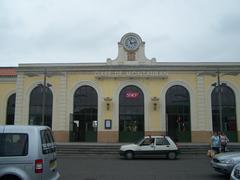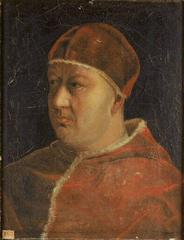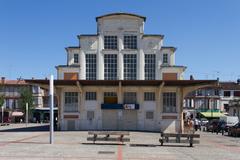Château de Riblaye Visiting Hours, Tickets, and Montauban Historical Sites Guide
Date: 14/06/2025
Introduction
Nestled on the outskirts of Montauban in southwestern France, Château de Riblaye is a striking emblem of the region’s aristocratic and architectural heritage. Built in the 17th century, this privately-owned château exemplifies the transition from fortified noble residences to elegant country estates, reflecting both the defensive priorities and the artistic ambitions of its era. Notable for its red-brick southern façade, protective moats, and artistically-rich interiors, Château de Riblaye is a rare and evocative destination—accessible to the public only during special events, such as the annual European Heritage Days. Together with Montauban’s wealth of historical attractions, the château offers visitors a unique opportunity to immerse themselves in the cultural and architectural evolution of the Occitanie region.
This guide provides a comprehensive overview of Château de Riblaye: its history, architecture, visiting information, and practical tips for exploring Montauban’s top historical sites. For up-to-date details, consult Wikipatrimoine, Monumentum, and the Montauban Tourist Office.
Table of Contents
- Introduction
- Historical Overview and Architectural Evolution
- Cultural and Heritage Significance
- Architectural and Artistic Highlights
- Visiting Information: Hours, Tickets, and Accessibility
- Practical Tips for Visitors
- Montauban Historical Sites and Nearby Attractions
- Events and Special Access
- Frequently Asked Questions (FAQs)
- Conclusion and Further Resources
Historical Overview and Architectural Evolution
Origins and Early Development
Château de Riblaye was founded in the 17th century, a period characterized by the construction of grand rural residences by France’s nobility. Its southern façade and surrounding moat are enduring symbols of this era, blending defensive features with an emerging preference for comfort and artistry. The structure’s red-brick construction is a hallmark of Montauban’s architectural identity, influenced by the city’s prominence during the French Wars of Religion (Wikipatrimoine).
19th-Century Transformation
During the late 19th century, Comte Léopold de Gironde undertook substantial renovations, reimagining the interiors with gilded and polychrome leather wall hangings to serve as a backdrop for his distinguished art collections. This period marked the château’s transformation from a defensive residence to a showcase of aristocratic culture and luxury (Wikipatrimoine).
20th-Century Artistic Enrichment
The early 20th century brought further artistic flourishes, most notably the vibrant frescoes by Paul Pujol in the château’s private chapel, adding a unique spiritual and creative dimension to the estate.
Cultural and Heritage Significance
Château de Riblaye stands as a microcosm of the broader evolution of French châteaux—from medieval fortresses to expressions of refinement and artistic patronage (Saving Castles). Its listing as a protected historic monument ensures the conservation of its unique architectural and decorative features, contributing to Montauban’s reputation as a center for history and culture (Saving Castles).
Architectural and Artistic Highlights
- Southern Façade and Moat: The brick façade and water-filled moat evoke both the defensive needs and aesthetic sensibilities of 17th-century noble architecture.
- Grand Salon: Lavish gilded leather wall hangings, installed during the 19th-century renovations, exemplify Renaissance and Baroque influences.
- Private Chapel: Paul Pujol’s early 20th-century frescoes imbue the chapel with both spiritual significance and artistic innovation.
- Protected Status: Key elements—façades, roofs, grand salon, south courtyard, entrance portal, greenhouse, west terrace, and chapel—are protected under French heritage law (POP Culture).
Visiting Information: Hours, Tickets, and Accessibility
Access and Location
Château de Riblaye is located at 570 chemin de la Riblaye, 82000 Montauban (Monumentum). It lies about 4 km southeast of Montauban’s historic center, accessible by car, taxi, or bicycle. Parking is available nearby, but visitors should confirm arrangements in advance, especially during event days.
Visiting Hours and Ticketing
- Regular Access: The château is privately owned and not open for daily public visits (POP Culture).
- Special Events: Public access is granted during occasions such as the annual Journées Européennes du Patrimoine (European Heritage Days) in September. Guided tours may be available, often free or for a nominal fee (Monumentum).
- Private Visits: May be arranged by appointment for groups or special events, at the owner’s discretion.
- Tickets: Obtainable via the Montauban Tourist Office or the Heritage Days program.
Accessibility
Due to the château’s historic nature, accessibility for visitors with reduced mobility is limited. The main courtyard and select areas may be accessible; however, many interiors involve steps and uneven surfaces. Contact the organizers ahead of your visit to discuss specific needs.
Practical Tips for Visitors
- Advance Planning: Always check event schedules and confirm access before planning your visit.
- Photography: Exterior photography is generally permitted during public events, but indoor photography may be restricted.
- Language: Tours are often conducted in French; English interpretation may be available at larger events.
- Local Amenities: Montauban boasts a variety of accommodations, restaurants, and markets—ideal for extending your visit.
- Weather: The best visiting period is from late spring to early autumn.
Montauban Historical Sites and Nearby Attractions
Château de Riblaye is part of a rich tapestry of Montauban’s cultural landmarks. Notable sites include:
- Place Nationale: A picturesque 17th-century square with arcaded brick buildings (Places and Things To Do).
- Pont Vieux: A medieval bridge over the Tarn River, offering scenic and historic value.
- Montauban Cathedral: A neoclassical religious site with significant art collections.
- Fine Arts Museum (Ingres Museum): Renowned for its collection of works by Jean-Auguste-Dominique Ingres and other regional artists.
- Local Markets: Experience Montauban’s culinary specialties, such as cassoulet and Pastis de Montauban.
For a complete list of attractions and events, consult the Montauban Tourist Office.
Events and Special Access
- European Heritage Days: The château opens its doors annually in September as part of this nationwide event, offering guided tours and cultural programs (Monumentum).
- Private Events: Occasional exhibitions, concerts, or private gatherings may be hosted with prior arrangement.
- Local Festivals: Montauban’s calendar features concerts, art shows, and traditional celebrations throughout the year.
Frequently Asked Questions (FAQs)
Is Château de Riblaye open daily?
No. The château is privately owned; public access is limited to special events or by private arrangement.
How can I visit the château?
Attend during special events like European Heritage Days, or inquire about private group visits via the Montauban Tourist Office.
Are guided tours offered?
Yes, typically during public events. Tour availability and language options vary.
What are the ticket prices?
Tickets for special events are often free or modestly priced. Check with event organizers for details.
Is the château accessible for people with disabilities?
Accessibility is limited. Contact ahead to discuss specific requirements.
Conclusion and Further Resources
Château de Riblaye is a rare treasure of Montauban, offering an immersive glimpse into centuries of architectural refinement and aristocratic culture. While public access is limited, special events provide invaluable opportunities for visitors to experience its unique interiors and artistic heritage. Pair your visit with an exploration of Montauban’s vibrant historical sites for a truly enriching journey.
For updates on visiting hours, event schedules, and guided tours, consult Wikipatrimoine, Monumentum, POP Culture, and the Montauban Tourist Office.
References and Further Reading
- Wikipatrimoine: Château De Riblaye
- Monumentum: Château de Riblaye
- POP Culture - Château de Riblaye
- Montauban Tourist Office
- The Crazy Tourist: Best Things to Do in Montauban
- Saving Castles: Château Renovation and Architectural History


